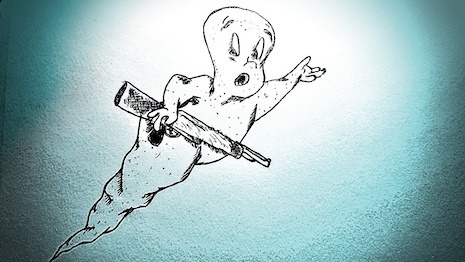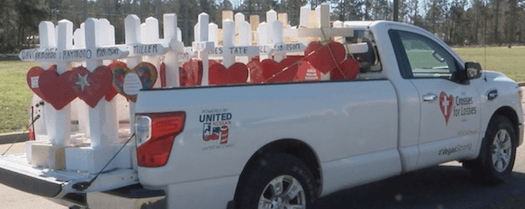Each four-foot-tall white cross is a memorial made of high quality, furniture-grade wood. The individual crosses weigh somewhere in the neighborhood of 30 pounds and each is adorned with a large red heart along with a photograph of a victim of a mass shooting, natural disaster, or other tragedy.
The crosses feature a serial number, the date the death occurred, and the location of the fatal incident.
The maker of these unique monuments is carpenter Greg Zanis, also known as “Cross Man.” Zanis maintains a log of each cross and the name of its corresponding victim. He records the information in a series of notebooks, 75 journals at last count. Mr. Zanis also records the names and phone numbers of the victims’ families. He does so so he can remain in touch with family members of the victims.
So far Zanis has cobbled together well over 26,000 crosses and has personally delivered them to various locations across the country, from his hometown of Aurora, Illinois to Sandy Hook to Orlando to Parkland to Dayton to Las Vegas, as well as a 4,200 mile roundtrip trek to Paradise, California where he delivered his homemade crosses and Stars of David for the victims of the horrific wildfires that claimed the lives and property of so many of its residents.
He even made and delivered crosses to Martha’s Vineyard after JFK Jr. and his family members died in a plane crash. The first crosses he made for a mass shooting was for the victims in Columbine. Although Zanis is a devout Christian, he’s memorialized Buddhists and atheists and others. It all about the memory, not the religion.
Mr. Zanis often sleeps in his truck and he prefers to remain out of the spotlight, avoiding the media whenever possible.
Since he started making and delivering the crosses back in 1996 when his father-in-law was murdered, he’s carried out his mission mostly on his own dime. Operating as a nonprofit called Cross for Losses, Zanis doesn’t charge for his work, his time, or the fuel it takes to deliver the memorials. He feels it’s the least he can do for those who’ve lost so much.
Crosses in Odessa, Texas
Recently, Mr. Zanis journeyed to Odessa, Texas to deliver seven white crosses that were placed at the corner of 2nd Street and Sam Houston. Each cross represented one of the victims killed by 36-year-old Seth Aaron Ator during a mass shooting that began after he was pulled over by a trooper for a minor traffic infraction, failing to signal before making a turn.
A few hours before Astor began his killing spree, he’d been fired from his job as a trucker. He called both 911 and the FBI to complain about his bosses, and then headed out to shoot people.
During the traffic stop, Astor grabbed a rifle and shot at two troopers through the rear-view window of his vehicle and then he sped away from the scene, where he left one officer wounded by his gunfire. While fleeing, Astor continued his rampage, firing at motorists and pedestrians. Then he ditched his vehicle and hijacked a U.S. Postal Service truck.
In all, seven people ranging from ages 15 to 57 died from gunshot wounds. Twenty-two others were wounded.
Astor Barred From Possessing Firearms
Astor’s criminal record showed a couple of brushes with law enforcement back in 2001 and 2002 that resulted in guilty pleas and court ordered probation.
Seth Ator was barred from owning guns because courts had ruled that he was mentally unfit. This information was entered into his permanent record, information that is designed to appear during the FBI background check that’s conducted when someone begins the process of purchasing a firearm.
So no, Astor was not legally permitted to purchase a firearm of any type. It was also illegal for him to have a gun in his possession.
How and Where Did Astor Get His Hands on the Gun?
In January 2014, Astor attempted to purchase a firearm but failed to do so because the nationwide criminal-background-check system flagged the mental-health determination. The system worked and the purchase was denied. The check prevented the sale of a gun to a person who was not permitted to buy or own a firearm.
However, Astor easily found a way to get his hands on gun by simply purchasing the rifle from an individual who’d illegally manufactured the weapon. Authorities believe Astor bought the gun from a Lubbock, Texas man who’d purchased parts on the internet, then built the gun and sold it to Astor. It is illegal to do so—build and sell a firearm without a license.
Private gun sales do not require background checks. For example, if you sold your grandfather’s old deer rifle to Billy Buck Jenkins you have no obligation to conduct a background check. However, if you have knowledge that Billy Buck, for whatever reason, is not legally permitted to possess a firearm, then it would be illegal for you to sell him the rifle.
The person who sold Astor the AR-15 style rifle he used in his shooting frenzy was not required to conduct a background check unless he had prior knowledge that Astor was not allowed to possess a gun. Of course, as the ATF investigation will determine, if he man manufactured the rifle from parts he’d purchased online (untraceable homemade guns are called “ghost guns” or “80 percenters”) and then sold the gun to Astor, well, that’s a felony.
From ATF
“80% receiver,” “80% finished,” “80% complete,” “unfinished receiver” are all terms referring to an item that some may believe has not yet reached a stage of manufacture that meets the definition of firearm frame or receiver found in the Gun Control Act of 1968 (GCA). These are not statutory terms or terms ATF employs or endorses.” ~ ATF
Are “80%” or “unfinished” receivers illegal?
Receiver blanks that do not meet the definition of a “firearm” are not subject to regulation under the GCA. The ATF has long held that items such as receiver blanks, “castings” or “machined bodies” in which the fire-control cavity area is completely solid and un-machined have not reached the “stage of manufacture” which would result in the classification of a firearm per the GCA.
See comparison examples:

ATF image
Making 80 percent receivers into working firearms is legal as long as the person making the guns is not a person who’s prohibited from possessing it and that the gun is strictly for personal use. They may not legally sell these homemade 80% firearms without first obtaining a federal license to sell firearms.
The end of Astor’s shooting spree ended when he was shot and killed by police outside a cinema in Odessa.
His death was not marked by one of Zanis’s wooden crosses.




